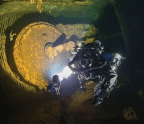Palau Shipwrecks Revisited
During World War II, Palau was a vital Japanese naval base in the Western Caroline Islands group and was headquarters for the 3rd Base Force (later re-named 30th Base Force in July 1944). It was a major advance shipping center and fueling station used for staging of amphibious forces and the transshipment of war-related materials. Included among the many vessels utilizing Palau’s natural harbors were major and minor combatant vessels, special fleet auxiliary vessels, navy and army merchantmen, and great numbers of harbor craft, including small vessels and lighters. Following the fall of Kwajalein in the Marshall Islands, the Japanese realized that the major combatant ships based at Truk were vulnerable to attacks by US aircraft. This prompted Japanese Second Fleet Units (5-6 heavy cruisers and destroyers) based there to be ordered to move westward to Palau. Major Combined Fleet units (battleships and carriers) also left Truk the first few days of February 1944 along with several convoys of merchantmen for Palau and ports beyond. Shortly after the 16-17 February attacks on Truk, Second Fleet units dispersed from Palau to the west.
During World War II, Palau was a vital Japanese naval base in the Western Caroline Islands group and was headquarters for the 3rd Base Force (later re-named 30th Base Force in July 1944).


Greater Opportunity Missed
To prevent Japanese naval forces from interfering with amphibious landing operations scheduled by General Douglas MacArthur’s Southwest Pacific forces at Hollandia, New Guinea, initial attacks on Palau were scheduled by the US Central Pacific Carrier Task Force 58 on 30-31 March 1944 as part of Operation Desecrate One. Three Japanese convoys left Palau through Toagel Mlungui Pass (“Western Passage”) the day before the planned operation. A total of 12 US submarines had been stationed in advance to intercept any fleeing vessels, apparently with the majority of them guarding the east side of the islands which were not used often and specifically not by heavy units. USS Tullibee was the first to spot a convoy leaving through the Toagel Mlungui passage; firing a spread of torpedoes, the sub managed to damage “a large AP” but USS Tullibee itself was lost after a torpedo made a circular run and came back to hit the sub. At mid-day, USS Tunny spotted a second convoy of “motley” merchantmen leaving through the pass. It was decided to let these vessels go in the hope that more important targets would be coming. Later that night, the flagship of the Combined Fleet, the battleship Musashi, along with the light cruiser Oyodo, two destroyers, and several merchantmen steamed out of the pass. One of a spread of six torpedoes hit close to the bow of the Musashi causing only light damage and the battleship managed to escape. Unfortunately, circumstances allowed the vessels in the three convoys to escape almost unscathed; if they had been delayed only one more day, the ships would have been easy prey to the US carrier plane attacks. Those that remained behind fell prey to the torpedoes, bombs, rockets, and strafing attacks unleashed during this operation and represent the majority of ships lost at Palau.
Operational Objectives
Primary objectives of Desecrate One included the
You’re reading a preview, subscribe to read more.
Start your free 30 days





